#then like Godzilla was directly influenced by that right
Explore tagged Tumblr posts
Text
This reminds me of the essay I wrote in university where my thesis was essentially anime could not have happened if the US didn’t nuke Japan.
I got an A and my professor wanted me to publish it.
If you think about it, Shakespeare pioneered the genre of real-person fiction, paving the way for works such as Lin-Manuel Miranda’s Hamilton. Therefore, Shakespeare is directly responsible for Miku binder Thomas Jefferson. In this essay, I will
#kenzie shut up#no really#long story short the cultural exchange between the US and Japan wouldn’t have happened without military intervention l#then like Godzilla was directly influenced by that right#Godzilla impacted American filmmaking and began a cultural back and forth between Japanese media and American media#then Disney comes along with Bambi and that fucking inspires Astro Boy#and the rest is history!
16K notes
·
View notes
Text
Best of YouTube 2023
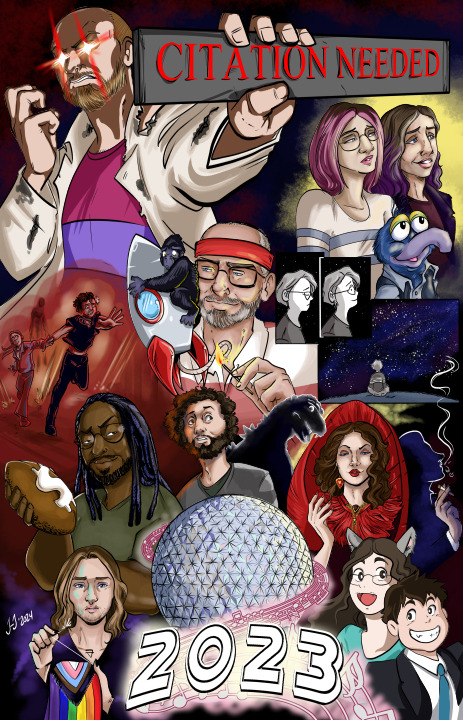
Yes, I did spend the first week and change of January on this. I wish I could have had it done for New Years, but too many people came out with incredible work in December, so waiting turned out for the best.
What these creators do are a huge influence on my life, I would honestly have difficulty doing what I do without them. That isn't to say that my favorites of the year are *only* on this image--It was almost impossible to narrow down my favorites. Many creators I wanted to include couldn't fit on a single page, and too many of them made more than one video I wished I could draw too!
But, to all of you, thank you for what you do. You're an inspiration.
For those who don't know, further is an explanation.
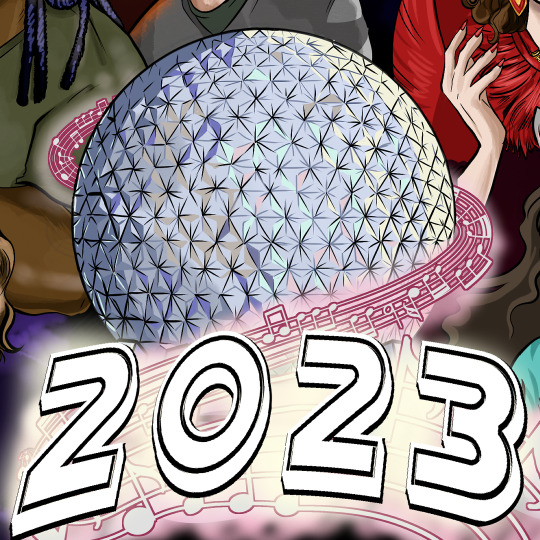
At the bottom center is an artistic masterpiece by Defunctland: "Journey to EPCOT Center: A Symphonic History." Over the last several years, Defunctland has risen from delightfully-entertaining commentary on decommissioned theme park attractions to occasionally dropping profound statements on the creation of art itself. "Journey to EPCOT Center: A Symphonic History" is worth treating like the cinematic experience it is: No second screen, you sit your ass down in front of a TV, set down the phone, and then you *watch it.* Any Disney, theme park, or independent film fan needs to pay attention to this one.

Bottom left is Caelan Conrad with their piece "Drop the T - The Deadly Consequences of Gay Respectability Politics." While I do think they've done more visually or artistically-daring pieces before, "Drop the T" is one of the most important videos released on YouTube in today's current climate of hate. We as queer folk (and our allies) need to understand how integral every identity of the queer experience has been since the start of the Civil Rights movement (and before!). While we are not identical, we *are* inseparable, and we deserve having our real history easily accessible.
TERFs and other conservative mouthpieces need not reply. Your opinions are trash. 😘
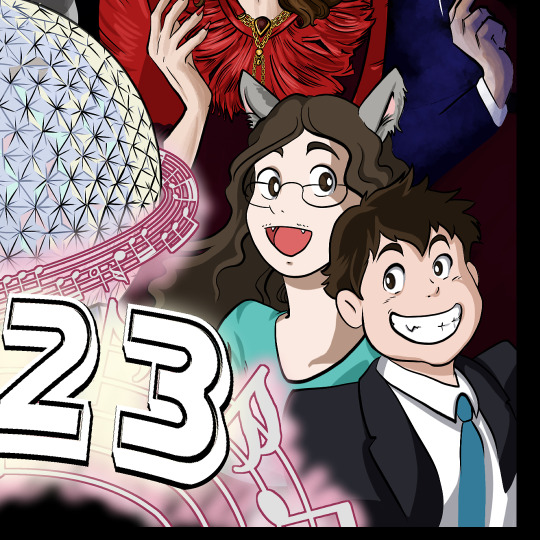
I cannot stop watching and rewatching this video by @patricia-taxxon, "On the Ethics of Boinking Animal People." It's not just a defense of furry fandom and its eccentricities, it's a thoughtful and passionate analysis of what the artform achieves that purely human representation can't. Patricia goes outside of her usual essay format to directly speak to the viewer about the elements that define furry media (the most succinct definition I've ever heard) and just how *human* an act loving animal cartoons really is.
As an artist who can draw furry characters, but never really got into erotic furry art, this video is a treasure. Why did I choose to have her drawn as a Ghibli character, hanging out with one of the tanukis from "Pom Poko?" Guess you'll have to watch, bruh.
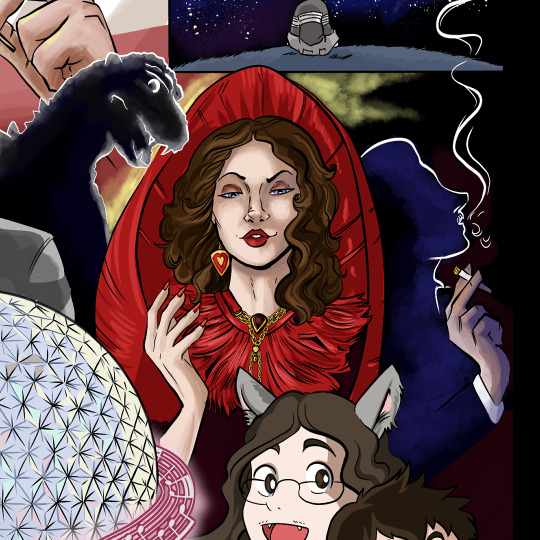
Philosophy Tube continuously puts out videos that I would put on this list--I'm not even sure that "A Man Plagiarised my Work: Women, Money, and the Nation" is the best work she released in 2023. However, this video got many conversations going between myself and my partner, and the twist on the tail end of the video shocked us both to such a degree that I had no choice.
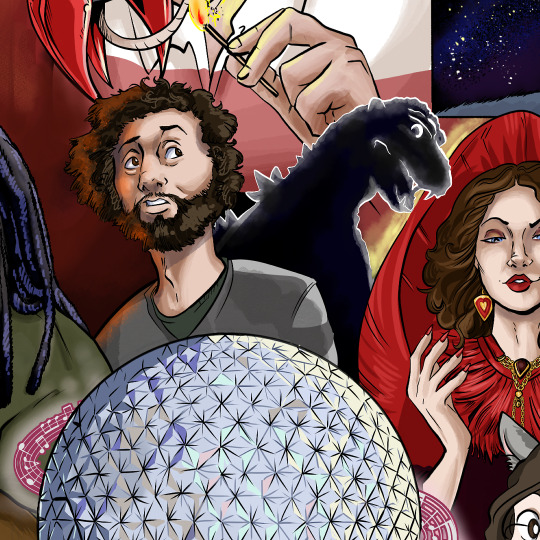
At the very tail end of the year, Big Joel released "Fear of Death." On his Little Joel channel, he described it as the singularly best video he's ever done, and I'm inclined to agree. However, for this illustration, I ended up repeatedly going back to a mini-series he did earlier in the year: "Three Stories at the End of the World." All three videos are deeply moving and haunting, and I was brought to tears by "We Must Destroy What the Bomb Cannot." While it may be relatively-common knowledge that the original Gojira (Godzilla) film is horror grappling with the devastation America's rush to atomic dominance inflicted on Japan, Big Joel still manages to bring new words to the discussion. Please watch all three of the videos, but if, for some reason, you must have only one, let it be "We Must Destroy What the Bomb Cannot."
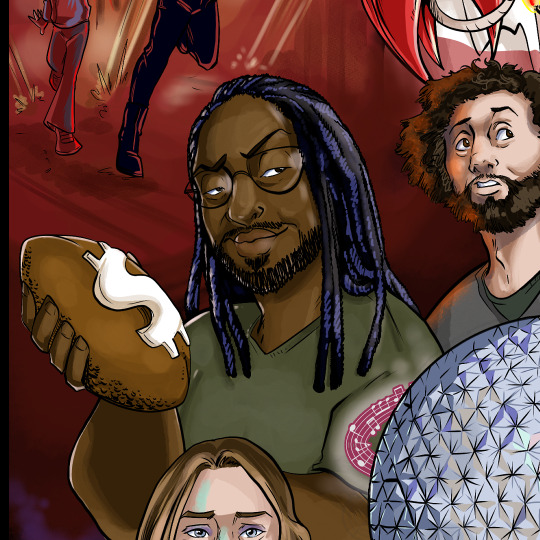
Y'all. Let me confess something. I hate football. I hate watching it, I associate seeing it from the stadiums with some of my worst childhood experiences, I despise collegiate and professional football (as institutions that destroy bodies and offer up children at the feet of its alter as a pillar of American culture)--
I. L o a t h e. Football.
But.
F.D. Signifier could get me to watch an entire hour-plus essay on why I should at least give a passing care. AND HE DID IT. I might think "F*ck the Police," the two-parter on Black conservatism, or his essay on Black men's connection to anime might be "better" videos, but this writer did the impossible and held my limited attention span towards football long enough to make a sincere case for NFL players--and reminds us that millionaires can *in fact* be workers. That alone is testament to his skill.
Sit down and watch "The REAL Reason NFL Running Backs Aren't Getting Paid." Any good anti-capitalist owes it to themselves.
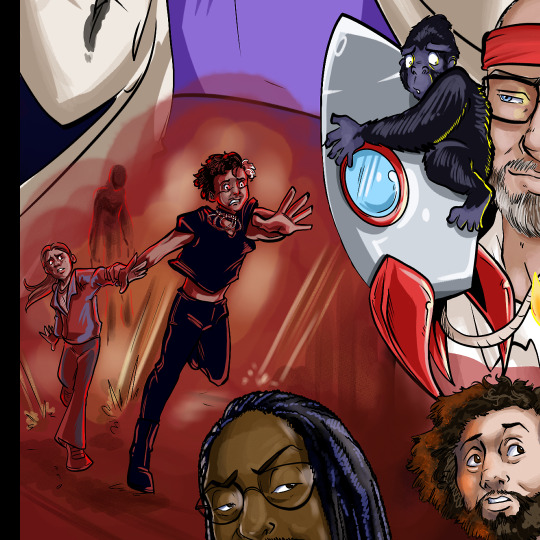
CJ the X continuously puts out stunning, emotional videos, and can do it with the most seemingly-inconsequential starting points. A 30 second song? An incestuous commercial? Five minutes of Tangled? Sure, why not. Go destroy yourself emotionally by watching them. I'm serious. Do it.
Their video Stranger Things and the Meaning of Life manages to to remind us all why the way we react to media does, in fact, matter. Yes, even nostalgia-driven, mass-media schlock. Yes, how we interact with media matters, what it says about us matters, and we all deserve to seek out the whys.
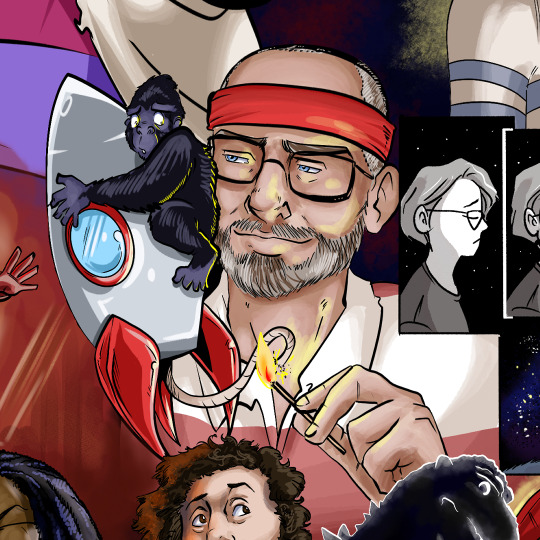
Folding Ideas has spent the last few years articulating exactly why so much of our modern world feels broken, and because of that his voice continuously lives rent-free in my brain. While the tricks that scam artists and grifters use to try to swindle us are never new, the advancement of technology changes the aesthetics of their performances. Portions of Folding Ideas' explanations might seem dry when going into detail of how stocks work in This is Financial Advice, but every bit of it is necessary to peel back the layers of techno-babble and jargon and make sense of the results of "Meme Stocks."
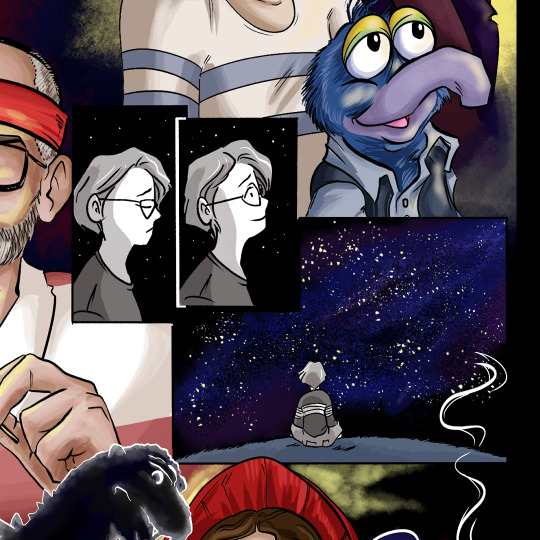
Jessie Gender puts out nothing but bangers, her absolute unit of a video about Star Wars might be my new favorite thing ever, but none of her work hit so profoundly in 2023 than the two-parter "The Myth of 'Male Socialization'" and "The Trauma of Masculinity." There's so much about modern life that isolates and traumatizes us, and so much of it is just shrugged off as "normal." We owe it to ourselves to see the world in more vivid a color palette than we're initially given.
Panels drawn after Kate Beaton and "Ducks: Two Years in the Oil Sands."

"This is Not a Video Essay" is one of the most intense and beautiful pieces of art I've ever put into my eyeballs. Why do we create? What drives us to connect?
I don't even know what else to say about the Leftist Cooks' work, it repeatedly transcends the medium and platform. Watch every single one of their videos, but especially this one.
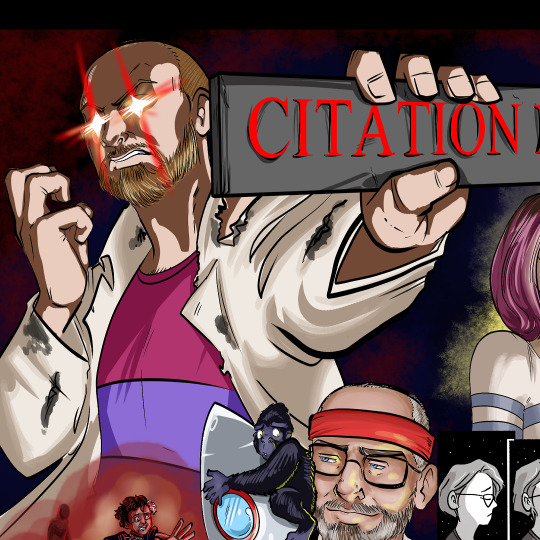
The likelihood you are terminally online and yet haven't heard of Hbomberguy's yearly forrays into destroying the careers of awful people is pretty slim. Just because it has millions of views doesn't mean that Hbomberguy's "Plagiarism and You(Tube)" isn't worth the hype. Too long? Shut up, it has chapters and YouTube holds your place, anyway. You think a deep dive into a handful of creators is only meaningless drama? Well, you're wrong, you wrong-opinion-haver. Plagiarism is an *everyone* problem because of the actual harm it creates--the history it erases, the labor it devalues, the art it marginalizes--which you would know if you watched "Plagiarism and You(Tube)".
Watch. The damn. Video.
In fact, watch all of them!
Thanks for reading this if you did.
#fanart#digital art#caricature#kate beaton#ducks#stranger things#apes#youtube#2023#best of 2023#video essay#hbomberguy#leftist cooks#cj the x#big joel#jessie gender#folding ideas#dan olson#jessie earl#neil and sarah#fd signifier#f.d. signifier#little joel#gojira#godzilla#philosophy tube#abigail thorn#caelan conrad#patricia taxxon#defunctland
1K notes
·
View notes
Text
HELLO welcome to another WAWF interview EXCLUSIVE
WHAT A VALENTINES FEELING !
This February marks the FINAL month and closing to WAWFswinter as well as an official YEAR OF WAWF WEDNESDAY [aka WAWFmag]
WAWF is grateful for all of the love and support that we have had throughout WAWFswinter and will be spreading that just a bit more this month with..
NEW WAWF ARTICLES EVERY WEDNESDAY with friends of WAWF who also wanna help us show just how much We ❤️ WAWF Wednesday
Read below for an exclusive interview and some behind the scenes moments with new friends of WAWF
Find out what exciting things they have in store

Who are we here with?
X: Hi I’m Xavier!
M: and I’m Melody
Do you guys have any specific hobbies or interests?

X: I like to paint and I like to watch a lot of fucking film.. like a lot of movies.. because of Melody though not on my own

M: I’m a film major. I’m a photographer too. I think that film and photography are some of the most easily express-able mediums. I love the fact that you can really customize whatever you’re trying to say. I’m a storyteller


Any specific influences for these hobbies?
X: Melody is one of my main interests for muses and then myself and just my life experiences. I take a lot from what I’ve been through to create
M: Absolutely my fam and Xavier. I’ve met a lot of really cool people who’ve inspired me to tell stories and have been right there with me. I think that school is one of the best places even if you’re not studying what you want to.. I’ve met a lot of people that way. Also just all of the media I consume.. Weapon of massive consumption.. that’s what it is

Any favorite films?
M: I showed him eternal sunshine of the spotless mind and he thinks about it every single..
X: I think about it Every. Single. Day


M: My favorite movie is Big Fish because it’s really corny and I just I love the concept of like it’s a simple story that makes me really happy. Godzilla anyone can do that shit! It can be good no matter how much money you put into it.. I love Bill Hader. I love white men who get to do what they want
X: I like Rent. Rent is so good. I’m obsessed with Rent. Rent is my everything

M: He loves Henry Selick. He loves stop motion
X: I do. Coraline is definitely one of my favorite things
X&M: and James & The Giant Peach
X: I have a Coraline key tattoo cause it’s just.. it’s such a good movie. I love that movie. Henry Selick is my favorite director
How’d you find out about WAWF?

X: I’m in class with Angel and that’s how I heard about it and of course I hopped directly on the instgram to find out all about it.. and then I told Melody
M: I found out from my boyfriend he’s pretty cool
WAWF Magazine pushes art fashion culture and much more Stay tuned for all of the exciting new things we have planned for the future
Words/ Curated by @vyngak
6 notes
·
View notes
Text
You know, Digimon aren't exactly a new concept. The world has known for six years that there exists a world within the digital network that directly influences our own, and that can break into our own through said network at any time.
And for six years, everyone's just gone, "Hmm, is it a problem that a giant kaiju monster could burst out of the internet at any moment and destroy the power plant? Should we be concerned that Buttmon fighting Poopmon might cause a plane's digital features to go haywire and crash the plane, killing everyone? Should we start talking about disconnecting our most important and vulnerable services from the parallel universe filled with monsters?
...Nah, I'm sure it's fine. I mean, if Godzilla spontaneously pops into existence in the middle of the airport and eats all the passengers, that's not my problem."
And having lived through the COVID-19 crisis and currently living through the climate crisis... Yeah. Yeah, that's exactly how people would behave. The convenience of the internet is too important to let a little thing like the occasional existential threat to all mankind keep us away.
Meicoomon is going to cause a nuclear meltdown or some shit, and we will not learn a goddamn thing. We'll just wring our hands and go, "Ooh, I hate those Digimon," and then keep right on hooking up power plants to wifi.
29 notes
·
View notes
Note
How long before you can put together a 3x3 Pulp Hero Qualification Chart like that one 3x3 Sandwich Qualification Chart
Right now as a matter of fact. Thank you for the idea by the way. By the way, if Tumblr doesn't load the image or cripples it's quality, I put it on Imgur: https://imgur.com/qFWnGnD
So, everyone, I present
The Pulp Hero Alignment Chart
made in an attempt to at least put the nonsense I talk about into a working order inspired by memes about intense discussions over sandwiches.

This by no means constitutes an "academic" definition of pulp heroes, you'll find no such thing outside of the purist definition which, by default, excludes at least half of the more commonly known pulp heroes. Instead this is more of a guideline for what I think sets up a few workable boundaries.
Some clarifications
Yes, Golden Bat was a pulp character. He didn't start off in pulps (neither did The Shadow), but he was published in Japanese pulps much the same and right within the same time period as The Shadow and Doc Savage. He is just as much of a 30s Pulp Hero as they are.
Already talked about Godzilla and Mothra here and it's been brought to my attention that King Kong also had the same start they had.
Elric first appeared in Science Fantasy magazine in 1961, right in the same format heroes like Conan made their debuts. Again, it's worth pointing that the history of pulp magazines in the US that "ended" with the 1950s is not the same as the rest of the world, and there's always been every decade publications calling themselves "pulp magazines".
Light novels factually started this way, and I could have put Megumin from Konosuba and Kirito from Sword Art Online in two of the bottom categories. I didn't, because I don't want to start a fight and I never want to talk about either of those things or to fans of either of those characters, but I do need to let you guys know that.
I want you guys to understand that I am, or at least trying to, lowballing the nonsense that is trying to establish "Pulp Hero" as a working term the way Superhero is taking into account everything you can fit under that umbrella. You see what I have to work with here

My reasoning for the picks in Radical Pulp Hero Anarchy were: Moon Knight and Ghost Rider were directly inspired by The Shadow, Mandy is maybe the greatest realization of "Pulp" in film I've ever seen and I'm definitely arguing Red Miller alone is a Pulp Hero if nothing else, Joseph Joestar invites a lot of comparisons to Indiana Jones as is, the Disney Afternoon had a remarkable amount of pulp-inspired stuff in it like Darkwing Duck, Talespin and Rescue Rangers and I'm including Gargoyles in it, Bloodborne's Lovecraft influences are well-known by this point, and you can trace a beeline from pulp sci-fi to much of Metroid's worldbuilding.
I'm not interested in arguing further whether or not the characters in the Radical Pulp Hero Anarchy section or the section above it are Pulp Heroes, I pretty firmly think most of them aren'tt, but again, it doesn't really matter if I think a character "counts", this stuff is completely out of my hands. It's up to your own discretion.
It took a lot of restraint to not just cap off the final part by reciting that part from The Ultimate Showdown of Ultimate Destiny.
#replies tag#pulp heroes#pulp fiction#the shadow#fantomas#golden bat#ogon bat#godzilla#mothra#king kong#zorro#conan#macready#the thing#the green hornet#the phantom#the spirit#phantom of the opera#sweeney todd#legend of the condor heroes#saci-perere#imaro#elric#indiana jones#scrooge mcduck#lavender jack#cobra#moon knight#ghost rider#mandy
96 notes
·
View notes
Text
Had a dream that trailer 2 of KH4 dropped and it introduced this ability where Heartless could influence him directly, so Sora had Darkness powers that you'd turn to light. It wasn't like Anti-Form though. There was a reaction command when you'd approach certain Heartless, like there was a Powerwild so the animation cued up of Sora holding it and cuddling it like a Dream Eater and he turned into this fusion. I made a sketch of it but gave up half way through because it didn't look right but you get the gist.

His clothes changed and he got certain aspects of a monkey. Instead of a keyblade, he used his tail and that crystal is supposed to be the keychain. (Looks more like Atlantis than a monkey in my drawing though...)
But the gimmick was that if you stayed as this Heartless for too long (like the meter to use the final attack for keyblade transformations) then it'd turn you into one of these-

You were maybe half its size though and basically tear stuff up like Godzilla until it wore off or you expended it (like Hypermode in Metroid Prime 3) It'd be cool to see a balancing feature like that where you could turn heartless into light (or Lux I guess) but if you don't do it right or abuse it then it turns you dark.
2 notes
·
View notes
Text
Godzilla - Ishrio Honda
I must admit that I was pretty excited to watch Godzilla. I have never seen this (or any of the movies in the franchise) before despite them being so popular. It honestly surprised me with how much I liked it. I wasn’t expecting a compelling story since most movies with mega-lizards tend to be along the lines of “big reptile shoot lasers” with little to no substance. However Godzilla had a compelling story focusing mainly on the relationships and struggles of the Japanese people dealing with the effects of this monster.
I originally had taken notes to keep track of specific parts I wanted to mention, but Google Keep decided that I don’t deserve nice things, so this might be a little rough.
Firstly, I want to take a second to appreciate the use of practical effects. While it was made in 1954 so there weren’t really any other options at the time, I do really think that practical effects would be fitting regardless. I loved the use of miniatures/models, real fire, planes on strings, and what seemed to be multiple different versions of Godzilla himself. I believe there was a puppet, full body suit, and maybe a model of some sort. I think it all looked really cool, and while it obviously doesn’t hold up to todays standards, I think for the time it came out it was amazing.
I think even without knowing what year this came out, it is clear that it was influenced by the end of World War II. With radiation and the mention of Atom and Hydrogen bombs frequently, and seeing the devastating effects on the cities, it is very clearly meant to represent the destruction and turmoil that fell on Japan with the atomic bombs. I don’t know whether or not it goes so deep as to say Godzilla is representative of the United States, but I think that would be a fair analysis. I appreciate the message that I got out of this movie, which was that there are no winners when it comes to warfare, especially when it escalates to atomic warfare. There is only raising the stakes and one upping the other until there is irreversible damage.

I think all the characters were pretty likable. I really appreciated Dr. Serizawa’s determination to keep his work a secrete to the world to prevent his invention only being used as a weapon of mass destruction. Relating this to something recent that came out, it reminds me of Jace and Victor wanting to find uses for Hextech in Arcane, and the issue of it falling into the wrong hands to be used for weaponry. The only time I really didn’t like something a character did was when roughly 2/3rds through the movie Ogata was determined to tell Emiko’s dad about them in the midst of everything that was happening. Like dude, there are more important things happening right now! Other than that I think everyone was likable and their reasonings were solid for what they did/wanted.
All this to say, I went in excited to finally see a movie that’s a classic, and I was surprised by how much I truly liked it. While there were a few scenes that dragged ever so slightly, I think the pacing in general was very good. I liked that there wasn’t a tease of Godzilla the whole movie just for a final reveal at the end. He was in it quite a bit and did some crazy damage which lead to really fun practical effects and forced perspective shots. I think the themes about the damages of war (particularly atomic warfare) were very apparent, but you can also watch the movie without directly relating this issue back to WWII. Overall it’s a very enjoyable film to watch with strong characters, themes, and a good message.
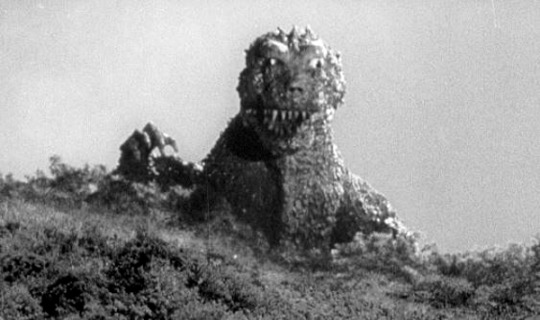
But also I don’t understand why they were surprised the Dr. Serizawa killed himself with the Oxygen Destroyer (love the name) at the end. He pretty much spelled out that if he uses this he’s destroying all research and himself so he would never be tempted to use it again or sell it. Maybe Ogata and Emiko are just dense.
2 notes
·
View notes
Note
Do you have any headcanons for pk before he found hallownest and his new/current form?
Boy anon, do I.
So it’s worth noting that Hollow Knight, as a game, has several interesting repeated thematic motifs. The ruined nest is one of them, introduced repeatedly with things like the resting place of the Baldur Shell, the Stag Nest, and the lair of the Brooding Mawlek. Given the, well, animalistic qualities that are retained by the insectoid “humans” of this setting, this smoothly transitions from depictions of wild animals to villages and towns (the Stag Nest itself, but also Dirtmouth, the City of Tears, Deepnest… we see few settlements that are not in a state of decline or ruin)
This is interesting when Hallownest is literally named, well, “Holy Nest”- and PK was quite clearly obsessed with the idea that it would be the greatest, the most sacred, the impeccable, that which would never be destroyed. And we see this obsession in the context that this ostensible impossible destruction came to pass anyway.
Bardoon- the main NPC who tells us about the wyrms- also implies they are dwindling in number, if not outright extinct. His comment on the dead body at Kingdom’s Edge is “with its like gone, the world is smaller.” So at least in this part of the world, wyrms are seemingly extinct, or all ‘passed on to other forms’ in a context where this is not treated as the evolution from a caterpillar to a butterfly.
It is also worth noting PK is… not really shown to be a liar. He is not necessarily shown to be forthcoming with information (Ogrim notes there were other vessels that PK didn’t tell him about, but, he is also not shocked or suggests that he was reassured there were not other vessels) but we don’t see him say things that are directly false as much as, as much as any other narrator in the game, he shows his bias.
This is interesting, because there is one time we find something PK wrote that is actively false, and it’s about the lands beyond the kingdom- the place PK was almost certainly born, and spent some amount of time before Hallownest:
These blasted plains stretch never-ending. There is no world beyond.Those foolish enough to traverse this void must pay the toll and relinquish the precious mind this kingdom grants.
Here’s the thing: even without Silksong coming out showing us that Pharloom exists, as another kingdom beyond Hallownest, Hollow Knight on its own is littered with people who came from somewhere else. Zote, in City of Tears, brags about how he’s seen far more impressive towers than these. Whether or not the towers were that cool is up for debate- but Zote probably didn’t just lie about the fact that buildings exist in places other than Hallownest. Cornifer and Iselda, while young according to Elderbug, are both grown adults and matured and lived among others before coming to Dirtmouth, and Iselda mentioning she thought it was a temporary stop suggests she was of the impression they would keep traveling onto another town.
Tiso and Cloth both came to Hallownest from other places. Quirrel and Ghost, while both returning to it from afar, still spent time out there and in Quirrel’s case we know for certain he met other people.
So PK, who we don’t have a lot of examples of him knowingly lying… is totally wrong about the void. Which seems stupid, because he’d have been out there. He’d have presumably seen people. Someone, somewhere, had to have interacted with a wyrm enough to realize they have powers of foresight, right? If it’s an attempt at propaganda, it’d be a poor one, because Ogrim- one of PK’s top enforcers- openly talks to Ghost about the idea that other people came to Hallownest and settled there, with PK’s sanction, from lands beyond. Hell, PK and his capital city openly bartered with the weavers of Deepnest- who came from Pharloom!
So, if it’s not a deliberate falsehood, what is PK’s statement at the Howling Cliffs?
It’d seemingly suggest a bias. That if PK looks back at his experiences beyond the kingdom, he saw it as a meaningless void, full of mindless creatures. Which makes a bit of sense, if we consider the size of the cast-off shell; the Pale Wyrm was enormous. Compared even to a prodigiously sized being like Bardoon, he is “too small” to be a wyrm.
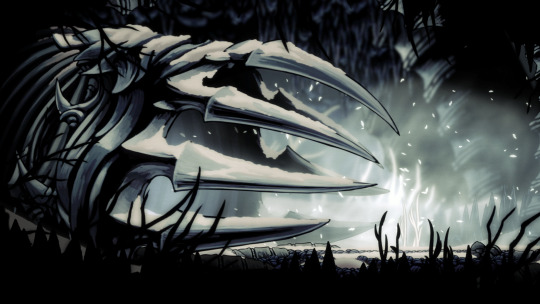
Existing at this sort of scale, it would be extremely difficult- if he even had the faculties such as a larynx or some form of telepathy- to talk to anyone. Something Bardoon’s size, maybe- but the vast majority of NPCs in the game are nowhere near Bardoon’s size. Most creatures are around the height of Elderbug, who isn’t even half the length of one of PK’s mandibles. And, speaking of Elderbug, it’d be pretty hard not to blame people for not, falling over themselves to talk to a Wyrm.
Especially because we are never told for sure that wyrms, uh, aren’t carnivorous. And a lot of creatures in this setting are.
The thing is though, if PK genuinely has a nihilistic perspective of the world and people because he spent a formative chunk of his youth isolated by virtue of being a godzilla-tier giant monster, this would tell us something interesting:
That PK didn’t have other wyrms around.
There’s more evidence in favor of this, too- the only name this entity is ever called besides “the king” or variants thereof is “the wyrm”. The. Singular. When anyone in Hallownest says “wyrm” they are referring to PK. There is a single mention of a “blackwyrm” by Ogrim in the White Defender’s journal entity, which is not elaborated upon, which would imply pretty strongly, if it was only relevant for a single battle, the blackwyrm, whatever it is, is probably dead; it is definitely out of the picture somehow.
PK does not have a personal name that would distinguish him from other wyrms; the only other wyrm we hear of is distinguished merely by color, which would suggest the “personal” part of his name is “Pale”- he’s the Pale Wyrm, as opposed to the Black Wyrm. Which is not much of a self-descriptor. It is the way wasteland wanderers might identify the wyrms- by whether the creature moving at the edge of their vision is a mountain of white flesh, or gray, or black, or red.
Wyrms do not seem to have much of an interrelated culture. If there’s any quality they are implied to share, it is seeking out and building kingdoms, luring bugs to them, which would suggest however their population goes, they have a tendency to be drawn towards other creatures, not each other.
This is fun, when it’s worth noting we don’t know how long the Pale Wyrm existed before Hallownest. He doesn’t imply he was doing anything he saw as important or valuable out there. If he sees it as a mindless environment, that might well suggest that he himself was basically operating on raw survival instinct- his concerns were eat, sleep, dig, look for more advantageous places to do those things. So he’d have no real reason to delay if he got it in his head he was going to do or be anything else.
Which could mean he was, at least by the standards of his kind, fairly young and inexperienced upon destroying himself to create the Cast-Off Shell. We can’t compare his shell to any other wyrms, because we have no other wyrms. He may not have even been fully grown.
This is something that came up in A Pale Stranger, and influenced my writing of PK there- that I personally read him as having been a very young entity. Even if he may have spent centuries in the windswept desert between kingdoms, he didn’t learn very much or become particularly worldly. He was not educated by others of his kind, and he did not form connections with smaller creatures.
So, Radiance, indignity of indignities, was more or less dethroned from her position by a punk teenager. I also personally like this read because it leads me to the idea that early-Hallownest and pre-Hallownest PK was at a point in his life where he actually had a lot in common with Ghost at the beginning of the game- a peculiar, unsettling stranger, but not necessarily a malicious one, figuring out what they are and what the world they’ve found themselves in is. Especially to the idea that this would come with an unhelpful inclination towards predation, because, what does “a large animal” do when it’s threatened or confronted, or even just trying to make sense of something? Attack it, usually.
But I also basically run on the headcanon- with the destroyed nests- that PK is functionally an orphan, whether this is simply the usual way wyrms operate or something unusual happened to him, he’s barely at best ever run into others of his species, and those encounters happened after he rejected that part of himself. And this kinda, creates some problems, because it means he basically has no model that isn’t trial-and-error self-assembled for what he even is.
#Hollow Knight#Pale King#readmore#Anonymous#Local wyrm fucked up by isolation and lack of role models; substitutes with being prodigiously good at killing things#the result is upsetting
116 notes
·
View notes
Note
So would you say Godzilla's and other kaiju messages are left or right leaning, kinda like how people say Shin and GMK are the same coin but on different sides?
There’s no question that most, if not ALL kaiju films are political in some way (granted, pretty much all art in influenced by politics, given that politics are fundamental building blocks of our lives and influence everything).Most of Honda’s films usually fell into very humanist, technically left-leaning categories, usually either anti-war, or pro-”brotherhood of humanity” messages, with occasional pro-science messages as well. The work of screenwriter Shinichi Sekizawa tended to be a little more egalitarian and fun-focused but his experience during WWII definitely affected him similarly to Honda. By contrast, Takeshi Kimura was a much more politically-charged, or at least less optimistic and less “fun” screenwriter and a card-carrying Communist. You can usually see criticisms of modern society peppering his films.If you listen to the commentary for Yongary: Monster from the Deep, it’s a VERY politically-charged film. Even if it’s not being didactic, it’s a film that is decidedly nationalistic for South Korea, trying to present what was, at that point in time, essentially a third world country as much more important and influential than reality would allow, at least for another few decades before SK really upped their game economically. Plus at one point, Yongary destroys a government building that was actually the headquarters of the Japanese occupation before Korean Independence in the 1940′s, so there’s some more flavor for you.
Modern kaiju films aren’t much different. Shin Godzilla is UNQUESTIONABLY a right-leaning film, lionizing the idea of the Conservative Fantasy that is “small government.” Hell one might say that Godzilla trims the red tape by FORCE and the remaining government officials intend to “rebuild it right.” This is all of course a criticism of the more left-leaning government that bungled the ongoing Fukushima disaster, which just happens to provide excellent fodder for those who favor a right-leaning government. Unfortunately the current Conservative government of Japan doesn’t exactly seem to be doing things any better and are actively TRYING to walk Japan backwards on several social issues. C’est la vie.GMK, by contrast, is almost entirely about owning up to your culture. Defending it, but not being afraid to criticize it. Being honest about the destructive qualities of your culture, but also being able to stand up for it and defend it so it can one day be better. It’s a film about taking some goddamn responsibility. And as a result that tends to be a left-leaning message.One could argue that we’re about to see that Right/Left flip-flopping with the Legendary Godzilla. While the first film was largely apolitical, it still somewhat lionized the military (and leaned a little too hard into the masculine, American ideal of the nuclear family, no pun intended) though thankfully not to the same repugnant degree that shit-covered piles of fetid garbage like Bay’s Transformers films excreted down our throats. KOTM looks to be leaning away from that, having the central two characters being a mother and daughter, and the plot being directly inspired by the oncoming and inevitable climate devastation that’s practically on our doorstep.
112 notes
·
View notes
Note
I just realized where we are rn in HxH is about Aug 2001. So now I am wondering if Togashi will have a special event corralating to 9/11 and I'm worried.
let me preface this response by saying I’ve been in research paper spiral for the last four months due to my impending advancement in june, and your question provoked a knee-jerk reaction that led to a 4h-long research spiral by someone whose specialty is absolutely not japanese foreign policy and nationalism.
the tl;dr version here, and then the explanation for it under the cut: I don’t think that’s going to happen. for one, they’re currently on a boat headed to Big Murderous Landmass (unless kurapika and co sink the whale). they’re not in yorknew/nyc. also, japan’s perceptions of 9/11 and the media representations of it are not as pervasive as american or even broader western collective trauma. while togashi is unafraid to address contemporary social politics, I don’t think he’s going to correlate a particular event to 9/11. he’s more concerned with the failings and strengths of humanity, as a whole or in parts, and might reference particular events to get across a greater point, not draw direct parallels.
now, a cut, and then several hundred words on 9/11 as a moment of collective trauma, japanese militarism, and media perceptions. it is 4000% nerdier than this ask expected.
I don’t think togashi is going to include a 9/11 parallel in a large part because of how japanese media, and anime in particular, addresses japanese communal trauma, and how togashi uses moments and evocations of these in his stories (at least, yyh, and hxh, although level e has its own quirks). namely that japan really doesn’t deal with 9/11 like americans do–but they absolutely have other traumas that make their way into anime, manga, and other media.
the thing is that, while 9/11 is absolutely a moment of international trauma (I work in india, and people there are highly conscious of it), the moment that hit the US was very different in other parts of the world. I’m old enough to remember the whole “where were you on 9/11,” itself a sort of marker of solidarity and belonging within the trauma that kind of unites people around a time. the plane crashes were broadcast everywhere in the US, and no one didn’t see it. but we got it live, fed right to the tvs in our classrooms at 8am. and america didn’t get attacked by foreigners before, not like this–problems existed “out there,” not in nyc, for however many times it’s been destroyed on film. (we have our own homegrown terrorists, but that’s a whole other can of worms.) and when it did happen, the country as a whole kicked into a jingoist gear on top of the collective trauma of someone murdering a bunch of americans. freedom fries. they were a thing.
it’s probably important to note here that media doesn’t exist in a vacuum. we’re perpetually influenced by things that happen, whether they’re collective and historical memories, personal experience, or social trends. we get our references and jokes from somewhere, and they sink into our brains and affect what we put out into the world. trauma does this more effectively than most things. trauma elicits a search for meaning, whether it’s a question of “why did it happen” or “why did it happen to me/us?” sometimes we find a meaning in the disaster, and sometimes we don’t. but it marks us and connects us (Halbswach 1992, Updegraff et al 2009). and it affects us for a long, long time.
in japan (and again, I’m not an expert on this), 9/11 is a moment of international trauma that marks japan’s re-entering into the international military sphere, but also economic flux. of the approximately 3000 people killed in the twin towers attack, 316 were non-american, including 26 japanese nationals. japan joined the war coalition almost immediately, and spent billions of USD to support the “war on terror,” while also dealing with things like shohei koda’s beheading in 2004 or the kidnapping and release of 5 journalists and anti-war NGO workers the same year, which arrived back in japan only to be ostracized for “causing trouble” for japan, with accusations that they had “got what [they] deserved” (x, x). the effect on the news media in japan was of increasing conspiracy theories and warmongering, while simultaneously wary of tensions with china, north korea, and taiwan. basically, japan politically and militarily had a lot of pots on the fire, and was feeding yen to the american pot real fast. the japanese SDF pulled out of central asia in 2007, and it’s still a divisive subject from the papers I read, but it’s more about the military than 9/11. 9/11 is not, for example, the topic of a j-drama directly or indirectly. shohei imamura’s short film “japan” in the september 11 (2002) anthology is a parable set during world war ii, although he’s much more famous for his palme d’or wins and a film about hiroshima (black rain, 1989). and uh. apparently pokemon black and white has a reference to ground zero in their map of not!nyc?
japanese media’s collective trauma in anime is often the deep personal connection with the atomic bomb, or terror attacks and natural disasters on japanese soil. which makes sense: humans will generally latch onto things that affect us personally, whether it’s a cute puppy video shown to us or an act of terrorism we watch on television. for the US, we were–and still are–being forced to confront our place in the international community (hero, victim, villain, collaborator, all of it–and americans are not very good at shades of gray) through the “war on terror,” and it comes out in everything from comic book movies like bvs directly evoking 9/11 while cavill!supes ruins buildings to kill zod, to the rise of partisan tv news. but we don’t evoke nuclear war or radioactive waste with the same reaction that japan does–there’s a lot of fear of the bomb in the 1950s and 1960s, like with dr. strangelove and them!, but it’s centered less around the impact of the bomb and its literal or metaphorical nuclear fallout, and more on the fear of the other or an outsider destroying good ol’ american culture. or giving us superpowers. (personally, the closest I think american art and literature ever got to japanese sentiments is with a canticle for leibowitz, which focuses on the cyclical nature of human failure and how the past becomes changed through the present.)
(please read a canticle for leibowitz, it changed my life and only grows more potent with age.)
for japan, the dropping of atomic bombs on nagasaki and hiroshima provides a similar and long-lasting moment of national trauma that’s been preserved in public policy and popular culture. and it’s not just grave of the fireflies or barefoot gen, anime that address the bombings through direct reference. the bomb transforms into concerns about nuclear destruction and environmental fallout, with kaiju like godzilla rising from nuclear waste. osamu tezuka’s work like astro boy is in direct response to the abuse and use of technology and hope for humanity’s future, and naussica of the valley of the wind is a fantasy post-nuclear bomb situation blended with hayao miyazaki’s love of humanity and nature (x, x). I think it’s worth noting that both tezuka and miyazaki personally experienced the 1945 bombings. miyazaki was 4, and one of his earliest memories is fleeing utsunomiya’s bombings. tezuka, at 16 and working in arsenal factories during the fire bombing of osaka, later wrote kami no toride (1977) about his personal experience, which served as both autobiography and condemnation of the vietnam war.
of more recent stuff evoking trauma, naoki urasawa actually uses 9/11 as a moment in billy bat, as part of getting to questions of humanity and modernity and technology and progress. other anime dealing with terrorism, like GITS:SAC, the “brain scratch” episode of cowboy bebop, and of course urasawa’s 20th century boys, locate terrorism not through 9/11 (and the underlying racism and not-us-ness) but more often with these japanese cults like the ‘aum death cult that carried out the 1995 tokyo subway sarin attacks, and the changing landscape of terrorism in japan. we could point to shinichiro watanabe’s zankyou no terror (or terror in resonance? iunno) as a potential 9/11 parallel, and I think it’s got the 9/11 connections, but watanabe himself places it closer to the 1995 terrorist attacks. he even commented how much “darker” zankyou no terror is than the film he was influenced by (the man who stole the sun (1979)), directly citing the 1995 attacks as one reason the last 30 years have impacted japanese understandings of terrorism. more recently, there’s also been connections to the 3/11 disaster with kimi no na wa, where shinkai explores his perennial theme of personal connection across space and time via a form of natural disaster. outside of anime, there’s also a growing body of literature on 3/11 and music, which is super interesting and well worth a look if you’re interested.
fwiw, I think it’s interesting that both urasawa and watanabe are explicitly interested in western and specifically american culture, but through a japanese lens. and not the sort of “japanese lens” that leads to the americas of g gundam or yugioh, which are The Most American Ever, but a more nuanced representation that explores technology, human connection, and modernity. which is the sort of lens creators should try to do when engaging other cultures, at bare minimum. (/soapbox)
trauma isn’t often addressed directly, but allegorically or displaced: lindsay ellis has a great pair of loose canon episodes on 9/11 and how film evokes collective trauma. while she doesn’t talk about anime or japanese films, she uses bollywood as a way to talk about indirect expressions of nationalist trauma. in the second video, she suggests that, for countries like india working through their own terror attacks with mumbai in 2008 (the 26/11 attacks), it’s easier to use other countries’ or places’ or–I would suggest–fantastical trauma rather than directly address it. so bollywood used 9/11 to understand its own trauma. not everyone does this–and a lot of times, I doubt it’s done purposefully, at least initially. but it’s there implicitly, informing decisions of artists and content creators that sometimes doesn’t get revealed until placed under a critical eye. it’s why editing and getting outside or sensitivity readers is important! for japan, the parallels aren’t to other countries, but fantastical situations in japan with Very Heavy Symbolism ranging from akira’s totally-not-a-bombs to kimi no na wa’s processing of the 3/11 disaster via comet.
as for togashi, he uses world events and figures as ways of exploring his own interests (yu yu hakusho has multiple “wow capitalism suuuuuuuuucks” subplots with yukina’s arc and the dark tournament, plus the very anti-war/anti-hate/anti-capitalism/”humanity sucks but people [kuwabara] can be amazing” sentiments of the chapter black tape; while hxh’s chimera ant arc has both a-bomb parallels and north korea/china references on top of killua’s soapbox about how corrupt and terrible governments can be). the parallel between “humanity sucks” and “people can be so very good” threads throughout togashi’s work. but it also uses a very buddhist understanding of rebirth and reincarnation to get these points across, whether it’s the unconditional vore love of pouf and youpi giving themselves to rejuvenate mereum after he’s nuked or the reincarnations of former humans as ants. but all of it connects to togashi’s personal experiences of things happening to and by japan, whether it’s the invasion of and tension with taiwan, the boom and bust of the economy, or the militaristic push by parts of the government under koizumi and abe. that, layered on top of the trauma that informs a lot of japanese media, makes for a fascinating playground togashi is more than willing to dig into.
I suppose this is all a very, very long-winded way of saying that while it’s possible togashi could include a 9/11 parallel, I don’t think it’ll be tied to some september 2001 date in the hxh universe. if he uses it, it will be 1: through a togashi/japanese lens; 2: unattached to a particular date; 3: layered in dialogue with broader war and terror issues togashi’s interested in exploring.
if you’ve made it to the bottom: holy crap congrats, hello, talk to me about anthropology of media. and if you’re somehow still interested in more, here’s an brief list of sources I used on top of the ones explicitly referenced in the post:
Baffelli, Erica. “Media and religion in Japan: the Aum affair as a turning point.” Working paper, EASA. 2008. (media-anthropology.net)
Broderick, Mick (ed.). Hibakusha Cinema: Hiroshima, Nagasaki, and the Nuclear Image in Japanese Film. Routledge and Kegan Paul International, 2014. (google books)
Deamer, David. Deleuze, Japanese Cinema, and the Atom Bomb: The Spectre of Impossibility. Bloomsbury Publishing, 2014. (google books link)
Japan pulls troops from Afghanistan (npr, 2007)
Japan ends ban on military self-defense (time, 2014)
Japan’s 10 years since 9/11 (al-jazeera, 2011)
Krystian Woznicki (September 1991). “Towards a cartography of Japanese anime – Anno Hideaki’s Evangelion Interview with Azuma Hiroki”. BLIMP Filmmagazine. Tokuma Shoten. (archived here)
manga responses to 3/11 (nippon.com, 2012)
Saft, Scott, & Yumiko Ohara. “The media and the pursuit of militarism in Japan: Newspaper editorials in the aftermath of 9/11.” Critical Discourse Studies, 3(01), 2006. 81-101
#hxh meta#japanese history#nuclear memory#symbolism#I'm so sorry#japanese media#9/11#26/11#3/11#all of the references#THIS is what I do for fun#...#sigh#long post#talk tag#Anonymous
33 notes
·
View notes
Text
SAINT’S ROW – WHERE TO GO?
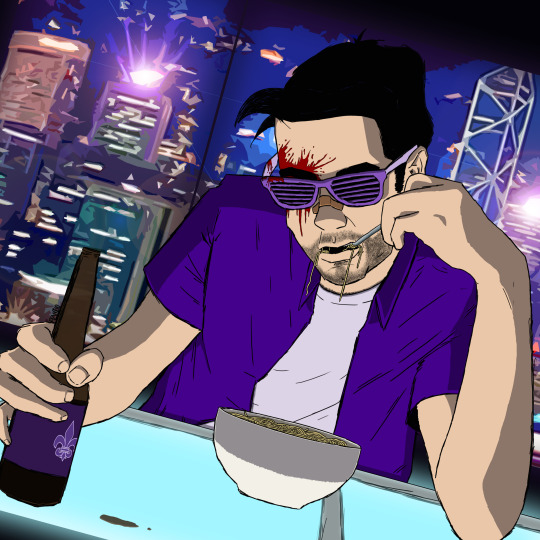
So, I’ve been playing a lot of Grand Theft Auto lately (namely GTA 3 for my last post) and it’s got me wondering: what’s happening with the Saint’s Row series?
As a die hard GTA fan I have a weird relationship with Saint’s; I inherently see them as mechanically inferior knock-offs of a staple of the medium, but at the same time I appreciate them and enjoy them as a way to tide myself over until the next GTA, which is where they evidently thrive. They’re undoubtedly fun and do a great job at emphasising player agency, creativity and fulfilling power fantasies as opposed to attempting to mirror real life with 1:1 physics and photorealistic graphics.

If you’re not super familiar with the Saint’s Row series, it’s basically the best Grand Theft Auto-like out there, with the major difference being that you get to create your own protagonist. Developed by Volition and published by THQ, the first two games took concepts directly from GTA (largely in a good way) with a focus on cartoony gags and violence; a way for Volition to make the most of their game engine, which has always been decidedly less graphically and mechanically impressive as Rockstar’s in-house engine. From Saint’s Row: The Third the series doubled-down on its whacky aesthetics, meta humour and ridiculous sexual innuendo, adding more layers of fucked with each release.
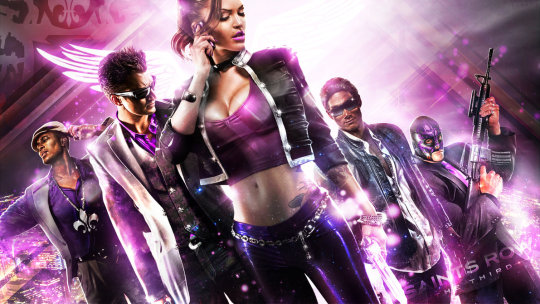
It’s important to note that the Saint’s Row series has always prospered in the absence of Grand Theft Auto, with each game coming out either just before the release of a brand-spanking-new GTA or in the middle of a GTA drought. Critically, it’s had a great run. From Saint’s 1 in 2006 to 4 in 2013, the series was a consistent critical and commercial hits, likely as a result of the release window of each game. The fifth game in the series, however — Saint’s Row: Gat Out Of Hell (2015) — slumped big time in comparison to its peers, largely for its continued re-use of old assets and mechanics and its disinteresting yet over-the-top narrative.
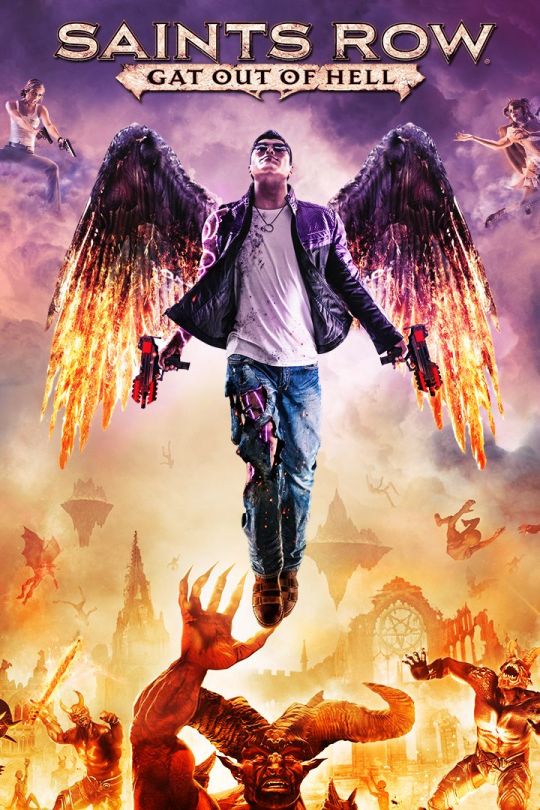
But that’s it for the Saint’s series so far. Agents Of Mayhem — a futuristic MOBA set in Seoul, South Korea with stringent narrative ties to the Saint’s Row series — released last year to critical meh-ness. But other than that there’s been no word on the Saint’s series itself since 2015. It seems strange to me that a series which has largely been a success would go away for so long without any word on its prospective future. I can safely imagine the Saint’s will make a return at some point in the future, but you would think that as Grand Theft Auto V’s decline has finally begun and GTA 6 is likely to be three to five years away right now would be the perfect time to release another fun stop-gap.
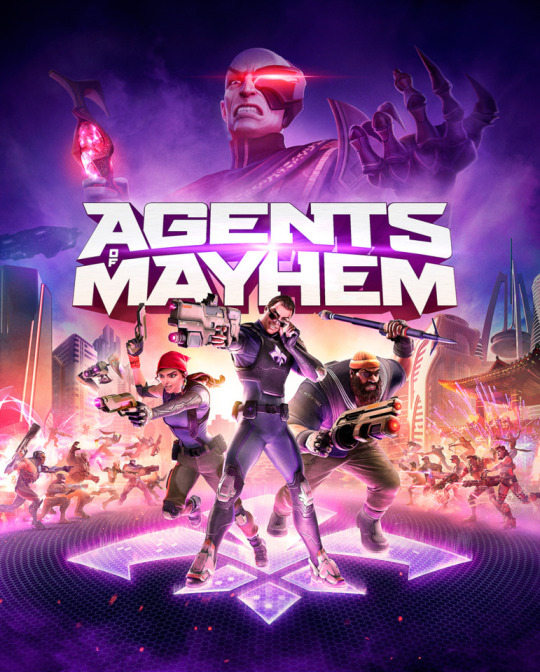
Even with an open-world behemoth like Red Dead Redemption 2 on the way, something in this vein definitely stands a chance at success. Saint’s has its own very unique flavour and dedicated fanbase.
It’s tricky, though. It makes sense to release a new Saint’s Row game, but how would you do it? Saint’s Row IV was fun, but with Gat Out Of Hell not doing so well I would argue that it to be risky to commit once again to far-fetched superhero fantasies. I also think doing this for a third time would paint Saint’s Row into a corner.
I also don’t think they could go completely serious, because that just wouldn’t be Saint’s Row, but to portray realistic street gangs in a silly and cartoonish way might border on being straight-up offensive.
So, where to?
I think the Saint’s have to go international. For three games the series has been stuck in the American city of Steelport, but imagine a fish-out-of-water scenario set in London, Paris or Tokyo. The humour comes from the balls-out swagger of the Third Street Saints, or just you (the Boss) clashing with a straight-laced and wholly different culture. Picture Dead Rising meets Sleeping Dogs, with a dash of Sunset Overdrive.

The elements of the Saint’s series that have never really agreed with me are the side-characters, who are often one-note cartoons with a gimmick and no true personality. In Saint’s 3 there’s a pimp who only talks in auto-tune. Real funny… I say do away with this shit and take a British approach to humour: make your protagonist the butt of the joke instead of the protagonist making everyone else look dumb. In a city like Tokyo you can indulge those sexual elements of Saint’s Row in a more subdued way, while also making a statement on America, its influence over the world and how it is seen by other countries.
Get fucked, Shaundi, you pot-smoking hippie stereotype.
Go away, Pierce, you absolute nothing of a man.
Hit the bricks… whoever else is left.
Japan’s rich cultural identity would make for an insane playground, with crazy shit like Godzilla, Samurai, the Yakuza, anime and the representation of more meta pop cultural phenomena in video games, like Pokemon, Mario and Metal Gear Solid.

“Boss! We’ve got to destroy the ‘Hard Cog’ before it launches its payload all over Downtown Tokyo!”
I would personally play the shit out of a good GTA-like set in Tokyo (since Rockstar have declared their disinterest in using the city as a setting, citing its street layout and infrastructure) with a funny narrative, cool combat and high level of personalisation.
Hell, expand upon the personalisation. Make it a fully formed street crime RPG instead of just a character creator. Game development is that easy, right?
If I stop to think about it though… I guess a lot of this stuff has already kind of been done by the Yakuza series…
Nah, fuck that. Crank it up to 69 and blaze up some sushi rolls, it’s time to get culturally insensitive up in this GTA-clone. I know I started by suggesting that it be set in London or Paris as well, but is just too perfect to pass up!
Either way, I think you understand what I’m getting at. Saint’s Row is a good franchise. A successful franchise. I think it’s high time for another instalment, along with a breath of fresh air for the franchise as a whole.
This series can go anywhere and do anything. I think it’s time they embraced that.
What do you think? Are you a fan of the Saint’s Row franchise? And if so, where do you reckon it should go? Hit me up in the DM’s, or through Twitter or Facebook and let me know where your head’s at.
- Article & illustration brewed in-house -
1 note
·
View note
Text
Dust Volume Five, Number Six

Photo of Anna Tivel by Matt Kennely
This edition of Dust considers twee pop and 1990s influenced electronica, Malawian street music and stenchcore and a wonderfully understated, gorgeous record by folksinger Anna Tivel (pictured above), among other musical finds. This time, writers included Andrew Forell, Jennifer Kelly, Bill Meyer, Isaac Olson, Peter Taber and Jonathan Shaw. Enjoy!
Barrie — Happy to Be Here (Winspear)
Brooklyn based multinational twee poppers Barrie’s debut album Happy to Be collects a charming array of sweet, feather-light classic AM radio-influenced songs performed by leader Barrie Lindsay (voice/guitar), Spurge Carter (keyboards), Dominic Apa (drums), Noah Prebish (guitar/synths) and Sabine Holler (bass). Lindsay’s songs subtly and acutely describe life as a newcomer to New York. The production and musicianship on Happy to Be Here is never less than expert, full of detail and space that allows each instrument room to breathe. As a singer Lindsay is polite to the point of being demure, and the band follows her lead. Pretty harmonies, delicate guitars and keys, tasteful drumming, unobtrusive but effective bass. You’ll hear echoes of Laurel Canyon, 1980s white soul and The Style Council at their most languid. Perhaps if Barrie weren’t quite so Happy to Be Here the debut would have more impact but if one is considering punting down the East River to a picnic this would be an ideal soundtrack.
Andrew Forell
Big Bend — Radish (Self-Release)
Radish by Big Bend
Nathan Phillips works in one of music’s uncanny valleys, a place where experimental electronics and ambient drone converges with semi-narrative pop. These eight songs enlist avant garde collaborators—Susan Alcorn on guitar, Laraji on zither, Shahzad Ismaily on percussion and moog and Phillips’ bad-ass opera-singing mother Pam on vocals — to create music that is warm, human and accessible. Phillips himself sings plaintively on a number of tracks, inserting vulnerability and uncertainty into a glitchy, glossy texture of electronics; he might remind you of Dntel. Elsewhere tracks veer off into untethered, unpredictable zones; “03 12’-15’,” the track with Alcorn pits trebly abstract guitar against the warmth of synth and piano. “Swing Low” centers its dreaming agitation around Pam Phillips’ spectral soprano, which is inviting but also remote. Electronics buzz and twitter around her like mechanical insects and birds. The Laraji track “Four,” lays in the pinging, tremulous tones of electrified zither over fat resonance of acoustic bass. It’s full of magic, or at least sleight of hand, and you expect something wonderful to emerge from its eerie cascades of dream-sequence zither notes. Shahzad Ismaily works his customary wonders, coaxing strange atmospheres out of the most skeletal of notes and rhythms. With these songs, you feel like you’re waking up in a strange country, not exactly unwelcoming, but not what you were expecting either.
Jennifer Kelly
Com Truise — Persuasion System (Ghostly International)
LA musician Seth Haley, AKA Com Truise, releases nine short tracks of woozy 1980s influenced electronica on Persuasion System. Listening to foregrounded hi-hat driven beats, fretless bass sounds, giant swathes of anthemic synth, you’re almost waiting for Curt Smith and Roland Orzabal to start ruling the world again. Haley is unafraid to reach for the big emotional release. That he doesn’t always hit it is due more to familiarity with those triggers than any lack of compositional skill on his part. When it goes a little darker on the drum & bass driven “Laconism”, the mock doom epic “Privilege Escalation” and the ambient restraint of “Gaussian” Persuasion System shows Com Truise’s aptitude in using stadium synth pop tropes to translate big sounds into big statements.
Andrew Forell
Shana Cleveland—Night of the Worm Moon (Hardly Art)
youtube
The La Luz leader turns introspective on this eerie solo album, sketching glowing just-off soundscapes with a squeaky acoustic guitar and voice. Like many of the songs, the single “Face of the Sun” subdues a spaghetti western swagger into just a hint of wide western horizons; there are bits of cello and bowed bass in the interstices of “Night of the Worm Moon,” shading the folk-acoustic-surf tones towards baroque. Cleveland sings in the common space between bewitching beauty and sing-song madness, Ophelia-esque and surrounded with flowers. She takes command, however, with her guitar, which defines and directs and originates this fetching dream state. Gorgeous, floating, spectral and surprisingly empowered.
Jennifer Kelly
FACS — Lifelike (Trouble in Mind)
youtube
FACS constitutes the latest iteration of the ongoing partnership of singer/guitarist Brian Case and drummer Noah Leger, who each discharged those same duties in Disappears. Expressed mathematically, 2/3 FACS = ½ Disappears, but FACS ≠ Disappears. While the old band’s music moved in a quick and linear fashion around Case’ bleak bark, this new ensemble, which is rounded out by bassist Alianna Kalaba, prefers modular construction and choppy flow. Kalaba’s distorted tone, which recalls Graham Lewis’ playing in mid-1980s Wire (especially live), is a looming presence, stomping through Leger’s sequences of chopped-off rhythm patterns like Godzilla playing a kid’s game with the real estate: “I think I’ll stomp every third house on this block. Next block, I’ll kick every tree to the left. Do I step on the lines, or jump on the cracks?” Case’s guitar blows in and out of the grooves’ vast empty spaces like a flock of metal-coated swallows, absorbing the fading light one moment and then banking up to reflect tiny flashes of the distant red sun the next. His singing has also changed, inching incrementally from the monochrome of yore towards a world-weary, side of the mouth croon. Why, you wonder, does this Chicago band sound so bleak? Hey, it snowed twice in April; what more do you need to know?
Bill Meyer
Forest Management — Passageways (Whited Sepulchre)
Passageways by Forest Management
Electronic musician John Daniel may call himself Forest Management, but don’t be fooled; there’s nothing pastoral about this music. The passageways he had in mind when he composed the music on this LP are remembered from a childhood home in a suburb of Cleveland, and he made the stuff in an apartment in Chicago. Daniel nicely straddles the digital/analog divide by playing a laptop computer but recording some of the music to reel-to-reel tape deck. This enables him to achieve a blurry patina of nostalgia-inducing atmosphere that’ll sit right with Boards of Canada fans. But where BOC used beats and samples to highlight their emotional messages and keep things moving, Daniel’s willing to let the music throb and drift. While Forest Management is a fully mobile project that is quite capable of occupying stages around town, this stuff is best appreciated under controlled conditions at home, where you can cultivate a mindset and manage the setting without facing any risks that one might face while zoning out in public.
Bill Meyer
Madalitso Band — Wasalala (Bongo Joe)
Wasalala by Madalitso Band
The two musicians of The Madalitso Band, who made their name on the sidewalks of Lilongwe (Malawi), play four-string guitar, cow-skin kick drum and homemade, one-string bass. If that sounds like a gimmick, albeit one born of necessity: it is, but all good street bands need one. Like all good street bands, the Madalitso Band’s necessarily formulaic music is inviting and undemanding enough to draw in spare-change-laden passersby all day, if need be. And, like most street musicians and small-time festival favorites, Madalitso Band’s crowd pleasing tricks don’t directly translate into gripping LPs. Wasalala, at 40 minutes, is about double the recommended daily dose (when was the last time you watched even a great busker for more than 15 minutes?), but, play it while you, say, put the dishes away, and this wholly charming, frequently gorgeous record is guaranteed to move the body and brighten the mood of any sentient person within earshot. Its pleasures are as real, necessary, utilitarian, and unvaried as a fan on a hot day.
Isaac Olson
Minotaur Shock — MINO (Bytes)
MINO by Minotaur Shock
On MINO, Bristol-based David Edwards turns away from his characteristic blend of orchestral acoustic and synthetic instrumentation to hone his synthesis craft. Edwards’ obvious composition chops have been a double-edged sword on past releases. Approaching his works as songs rather than tracks has lent them undeniable musicality; but since that approach is unidiomatic for beat-smithing, it sometimes has felt like the work of someone whose primary business was in sync for film dipping their toes into electronic music and bringing the resources of an entire soundstage orchestra with them. MINO’s focus on a single instrument results in a more inventive sound, defrays the risk of sounding excessively filmic, and retains Minotaur Shock’s strengths of earworm tunefulness and emotional sweep. The textures and polyrhythms bear a surface similarity to LA beat scene notables, while the album’s overall sunniness recalls Machinedrum, who underwent a similar turn to synthesis in recent years. A very different direction for Minotaur Shock and some of Edwards’ best work.
Peter Taber
MotherFather — S-T (Self-Released)
MotherFather by MotherFather
MotherFather, a four-piece band from St. Louis, makes broody, duel-guitar-driven post-rock that builds in a slow inexorable way like rough weather or a tidal surge. They build up layers of deep, shadowy sound, churning up the noise gradually so that when abrasive bass saws up through the bottom of “Burning” late in the album, its cinematic metal upheaval is as surprising as cathartic. Two of MotherFather’s members—guitarist Nelson Jones and bassist Brian Scheffer—run a studio in their spare time, and they surround these chugging, chiming onslaughts with clarity. However, the sound is gloomier and less buoyant than epic instrumentalists like Explosions in the Sky, more like the torpid reveries of vocal-less Mogwai or even post-rock-into-metal outfits like Pelican or Red Sparrowes. Guitars drive the train here—that’s Jones and Eli Hindman—but drummer Tim Hardy puts in a strenuous, battering days work on drums and you can’t move the tectonic plates like MotherFather does without muscular, fundamental bass.
Jennifer Kelly
Neolithic—S/T (Self-released)
Neolithic by Neolithic
Do genre labels really matter anymore? At various sites around the web, Neolithic’s music has been described as death metal, grindcore, hardcore and, in one especially bewildering formulation, “pitch-black death/crust.” This reviewer’s ears hear a pretty straightforward species of stenchcore all over this record, but that begs the question: What does “stenchcore” mean to you? In any case, the good news is that this is a terrific record. Nasty, brutish and way too short. The Baltimore band has only been making records for a little over a year, but the music exudes confidence and, whatever we want to call it, a song like “Myopia” demands attention. Its riffs are precise, its bottom end is deep, its textures and affect are simultaneously razor-sharp and dripping with miasmatic, fluid yuck. Sort of like a zombie’s mouth. One gets the feeling that’s something like what the band intends. Enjoy!
Jonathan Shaw
Ivo Perelman / Jason Stein — Spiritual Prayers (Leo Records)
youtube
Brazilian tenor saxophonist is never one to settle for half measures. If he has a good idea, he’s liable to make a series of records out of it. Google the words Ivo Perelman Matthew Shipp if you need an illustration. But some ideas are self-limiting, such as the one that generated this record. Perelman decided that he was going to record duos with free improvising bass clarinet specialists. There just aren’t that many of those around, so the total so far stands at two CDs; one with Rudi Mahall, the other with Jason Stein. Stein has deep roots in the New York area that Perelman has called home for years, but the two men had never met before they unpacked horns and improvised this album in a Brooklyn studio. You wouldn’t know it from listening, though; they two men throw themselves into the endeavor with the sort of fearlessness that only deep acquaintance or utter self-possession. The first quality only existed on a metaphysical plane — each man reminded the other of a beloved and long-lost ancestor. The latter, both have in spades, and for the best of reasons. Both are masters of their horns, both are close listeners and responsive partners, and the hitherto empty field of tenor saxophone / bass clarinet duets turns out to be rich earth. The horns can sound quite like each other, or hit pitches as distant as opposite ocean shores, and the musicians traverse such spaces in a split-second.
Bill Meyer
Sick Gazelle — Odum (War Crime Recordings)
Odum by Sick Gazelle
Releasing improvised music involves risk. Musicians often sacrifice quality control for spontaneity, and some seem unable or unwilling to abandon, edit or control their experiments. However, when it works, the rewards are many. Former Crucifucks and Sonic Youth drummer Steve Shelley joins Chicago saxophonist Bruce Lamont (Yakuza and Bloodiest) and ambient guitarist/bassist Eric Block (aka Veloce) to produce a debut album Odum under the moniker Sick Gazelle. The first three tracks combine slow-core jazz and illbient atmospherics with Lamont’s saxophone ,a powerful yearning voice sympathetically supported by Shelley’s percussion and Block’s layers of guitar and bass. The longer pieces “Atlantic” and “Pacific” work best, as Sick Gazelle builds grand spacious structures with an innate sense of dynamics and a muscular foundation. On the short final track “Laguna” the band lets go as Lamont foregoes the sax for a chant-like invocation over a driving rhythm that sounds closer to Sonic Youth than jazz. Odum is dense swamp of sound, easy to get lost in, harboring beauty and danger in equal measure. Leave the compass and venture in.
Andrew Forell
Stander—The Slow Bark (Self-Released)
The Slow Bark by Stander
Pensive guitar lines surge up into tsunamis. Liquid, lyrical melodies disintegrate under a firehose spew of distorted sound. Stander shifts dynamics like it’s wielding a weapon, and maybe it is. These long-form instrumental meditations build from pastoral, serene interludes into raging towers of feedback (and vice versa), though you can often glimpse the original plaintive theme shrouded in noise and fury. Stander is a Chicago-based heavy post-rock instrumental trio built around guitarist Mike Boyd (who, full disclosure, we know from his job as Thrill Jockey’s publicist), Derek Shlepr on bass and Stephen Waller on drums. On The Slow Bark, the band’s first full-length album, Stander masters the slow rolling crescendo in cuts like “Cicada Tree,” where a moody, pondering, unsettled guitar melody unspools so gently that the kick of drums, the onslaught blare of amplification, comes like a defibrillator, which maybe, at that point, you need. “Cold Fingers,” too, alternates the loud and the soft, the rage and the quiescence; it calms enough that you can hear how the interplay works, how Shlepr’s bass underlines and reinforces the melodic line, how a riff gets penciled in once, then returned to for an obliterating refrain. There are no vocals—just a subliminal growl near the end of “Cold Fingers” and some eerie altered voice effects tucked into “Cutting Ants, Conquering Ants”— but this is in no way just an extended instrumental jam. Stander’s tracks are carefully constructed, thoughtfully plotted, even if they all end up blown to bits.
Jennifer Kelly
Anna Tivel—The Question (Fluff and Gravy)
The Question by Anna Tivel
Over four albums, Anna Tivel has quietly been building a reputation as a formidable folk songwriter, a storyteller whose hushed voice weaves simple words into complex narratives about people on the outskirts of society. The Question is tensely, transparently lovely. Tivel’s voice runs toward the calm and matter of fact and never goes much over a conversational murmur. Her melodies, likewise, are precise and pretty. However, the lives she limns in her songs are unruly—a man transitioning to womanhood, a migrant testing a fence line, a homeless child trying to make it through the night—and the thickets of dense, conflicting instrumental sounds seem to echo these complications and strife. She makes wonderful use of strings—viscous throbs of cello, twitchy pizzicatos of violin—to underline but not sweeten her arrangements, and the guitars, too, have a clarity and sharpness that reinforces the acuity of her verses. “Fenceline”’s insistent piano and keening, tremulous strings underline the tension of the southern border crossing; the instrumental interlude zings with anticipation and fear. “Homeless Child” is more overtly folky, but still unblinking and unsentimental as it tells the story of an abandoned child with her own child coming. The refrain couldn’t be sadder or more beautiful, when Tivel sings, “And Jesus Christ, it don’t take much to go from just enough to nothing in the end, and oh my god, homeless child, the world will leave you hanging by a thread.”
Jennifer Kelly
Various Artists — Hearts and Livers: Global Recordings from 78rpm Discs, ca. 1928-53 (Canary Records)
Hearts & Livers: Global Recordings from 78rpm Discs, ca. 1928-53 by Canary Records
Ian Nagoski, the proprietor, curator, researcher, and dogs body of Canary Records, has assembled some marvelous collections of music from records that most 78rpm collectors would leave in the bin. But is that what the people want? Even the characters who populate the farthest corners of record nerd-dom are prone to the influences of groupthink and fashion, and they want you to come up with something just like your last hit, only different. One of the crosses on Nagoski’s shoulder is that while passion compels him to investigate shellac sides of woman whistlers and birdcall imitators, people remember him for his genre-spanning marvel, Black Mirror. Hearts and Livers is Nagoski giving people what they think they want and subtly chiding them as he does so. Both album emblem (there’s no cover — this thing is download-only, and thus not really a thing at all) and title can be read as gentle mockery of the enterprise. But once you get past them, Nagoski’s unerring knacks for selection, sequencing and sound restoration deliver the goods. Exiled rembetika singer Rosa Eskenazi’s quivering lament resonates with Horace Britt’s melodramatic cello recital; a sinuous Korean melody and a beseeching Turkish air impart a common stern spirit. Since he hasn’t written any notes to explain the compilation, it’s all just music, each track equally foreign and mysterious.
Bill Meyer
Various Artists — New American Standards Volume 2 (Sound American)
New American Songbooks Vol.2 by Kris Davis, Matt Mitchell, Aruán Ortiz, Matthew Shipp
To some, the Great American Songbook (which isn’t really a book, but a body of popular songs that captured the hearts of both general audiences and jazz musicians in the pre-rock and roll era) represents the acme of American musical creativity. But while some great and flexible material came out of that era, do we really want to concede that the middle of the 20th century was the best we could do? Careful, such thinking paves the way to donning an unflattering red ball cap. Sound American Publishing initiated the New American Standards series to investigate notions of Americanism and standards. Volume 2 taps four pianists not known for their frequent dips into the Songbook to propose material that speaks for communities didn’t quite make it into the original metaphorical volumes. Matthew Shipp proffers brooding extemporizations upon Protestant hymns composed by individuals you’ve probably never heard of. Matt Mitchell invests two tunes sourced from Bandcamp-era singer songwriters with solemn romanticism. Kris Davis’ prepared piano recasts Carla Bley’s “Identity Picks” as a quasi-gamelan reverie that invites the listener to consider which quirks of identify might lock you out, then and now, and what you might do with (or to) a piece of ubiquitous cultural equipment in order to make your voice heard. And Aruán Ortiz offers a luminous exposition of a piece by cultural critic and polymath Ed Bland. All four musicians played the same piano, which serves to make clearer the individual differences of the four players.
Bill Meyer
Various Artists — Tombstone Trance Vol. 1 (StabUdown)
Tombstone Trance Vol. 1 by Piezo
Fuzzy technoise is the game being played here with varying degrees of earnestness, as suggested by the goofball album art. Listeners may come for marquee names like Kerridge and Powell, though they’re easily outshone by some nicely varied lesser-known acts. Koehler’s “Below Andromeda” is rhythmically inventive but straight-ahead techno. “Mourning Etiquette” from Grey People isn’t far from the crunchy atmospherics of Modern Love artists. Entries from Bad Tracking and The Rancor Index take things to a considerably grittier, Wolf Eyes-esque level. Vanity Productions’ “No Peep Show Here” could be melodic drone from Yellow Swans, while Organic Dial’s “Absolute Other” is an unexpectedly delicate slice of dub-inflected ambient. Piezo offers a dramatic highlight in “Sponge Effect,” which morphs from a melodic arpeggio into an odd-time paroxysmic blob and back again. Hopefully a taste of more great things to come from all concerned.
Peter Taber
Woe —A Violent Dread (Vendetta)
A Violent Dread EP by Woe
This two-song EP is a welcome reminder of how good Woe can be (insert snarky pun here). The Brooklyn-by-way-of-Philly quartet seems to have found a stable line-up, with Lev Weinstein providing drums and Matt Mewton’s second guitar rounding out the band, as they did on 2017’s Hope Attrition. Weinstein’s drumming is less acrobatic than the whacko stuff he pulls off for Krallice — but Woe’s sound is more firmly anchored in black metal’s traditions. Woe’s cover of Dawn’s “The Knell and the World,” recorded by the Swedish band back in 1998, celebrates the continuity of that tradition. That doesn’t mean Woe’s music is derivative or pedestrian. The nine minutes of “A Violent Dread” flash past with a sustained intensity that makes the song feel half that long. Chris Grigg’s singing, playing and songwriting are sleek and tough, feral and rigorous. It’s peak USBM.
Jonathan Shaw
#dust#dusted magazine#barrie#andrew forell#big bend#jennifer kelly#com truise#shana cleveland#facs#bill meyer#forest management#madalitso band#isaac olson#minotaur shock#peter taber#motherfather#neolithic#jonathan shaw#ivo perelman#jason stein#sick gazelle#stander#anna tivel#hearts and livers#ian nagowski#new american standards#tombstone trance#woe
1 note
·
View note
Text
Body Horror and Cyberpunk – How technology shapes not just the world around us, but what it is to be human in a technological world.
I have had a long running interest in niche or fringe subgenres of films. Two such genres are cyberpunk and body horror. These two genres seem relatively distinct and certainly are aesthetically very different, but they have plenty of overlap in terms of what questions they ask and explore. Both genres heavily rely on the relationship between man and machine, and how it can enrich or destroy humanity, or what it is to be human. From the relationship between replicants and humans in the aesthetic definition of Cyberpunk Noir, Bladerunner, to Tetsuo’s mechanical mutations in the anime body horror classic Akira, these films act as prophecies, warnings, or explorations of everything that could go wrong with this sacred relationship. While cyberpunk focus’s more on how technology shapes the world around us, Body Horror is focused on how technology may shape our very bodies.

I will likely dedicate a few blog posts to exploring the ideas and theme’s of these two genres, but for this inaugural post I will be focussing on Katsuhiro Otomo’s masterpiece Akira, and the well known Japanese entity of Godzilla. While these films do not so much relate to how technology intereacts with creative processes, the human-machine relationship is the core, and therefor technology is acting as an influence.

In order to explore Akira, it is first important to establish some basic knowledge of Japan, Japanese film and most importantly the hopes and fears of the Japanese people post WWII. Japanese society was heavily wounded following the nuclear devastation's of Hiroshima and Nagasaki, a once proud and traditional state brought to its knees by sheer displays of foreign power and destruction, these detonations not only crippled the country strategically, they destroyed the previously strong Japanese identity. The fear of nuclear destruction is perhaps most famously identified and personified by Godzilla. A Japanese cinema staple, created from an offshore nuclear blast Godzilla is nuclear destruction incarnate. Japanese attitudes towards nuclear power can be seen directly through Godzilla’s depiction on screen, in the great Kaiju’s early films, he was little more than an unstoppable force of destruction, but as Japan’s relationship with nuclear power and industrial growth have developed, Godzilla has taken a new roll. He is often depicted defending Japan against other foreign Kaiju (giant monsters), representing Japan’s return to an independent and self sufficient identity, rather than a metaphor for fear of powers outside of Japans control. This concept is quite specifically developed around Japan’s relationship with nuclear power, however, it acts as a solid introduction into the fears and developments of the Japanese Zeitgeist. This is where I move onto Akira, and at this point, in order to avoid turning this blog into an essay, I will keep my plot summary brief, and imagine you have seen the film, if not I will link a plot summary at the end of this blog.

Akira takes place in a futuristic Neo-Tokyo on the brink of chaos, featuring the main character Tetsuo going through horrific mutations culminating in his transformation into a gigantic metal-flesh abomination with city levelling power, following a failed government experiment. The film is rich in metaphor and allegory, often juxtaposing body with industry, to represent the rich relationship between humanity and technology. Like Godzilla, Akira is an exploration into Japanese nuclear anxieties, but unlike Godzilla’s black and white polarized roles (i.e. destroyer vs defender), Tetsuo’s transformation represents Japan’s transformation into its new independent identity. His metal beast form, his sudden development of power, Japan’s industrial growth, is as threatening as it is exciting, representing Japan as a powerful state in its own right, independent and unafraid of outside forces.
The powerful messages in this film might initially come across as simply another doomsday fantasy, but it goes so much deeper. Akira is an astute exploration of how technology can shape our society, how rapid technological change can overwhelm us entirely, but can also push us to redefine humanity, to form new identities and overcome societal anxieties. It acts as an acceptance of the changes Japan has gone through post WWII and a return to Japanese ideals.
Akira plot summary: https://www.imdb.com/title/tt0094625/plotsummary
0 notes
Photo










ESSAY: JURASSIC CITY* Recently the hosts of the @kaijusaurus podcast covered the film GODZILLA VS MECHAGODZILLA II (Dir. Takao Okawara). Unfortunately Stephen and Ross didn’t think much of it. I, however, have always been a fan of this film (really there isn’t a Godzilla film I’m not a fan of, so maybe that’s not a fair metric by which to judge) so I wanted to offer a different perspective on the movie. GODZILLA VS MECHAGODZILLA II was released in 1993, the same year as JURASSIC PARK (Dir. Stephen Spielberg). As a result of their close production schedules it seems unlikely that either film was directly influenced by the other in any real way. Nevertheless one of the things which I find fascinating is how thematically similar the two films are. As noted by David Kalat, in the revised edition of his book A CRITICAL HISTORY AND FILMOGRAPHY OF TOHO’S GODZILLA SERIES (2010), the theme of GvsMG2 is “life verses artificial life” as articulated by MechaGodzilla pilot Lt. Berger (Sherry Sweeney). In the film we are introduced, for the first time, to G-Force; a United Nations scientific-military organization dedicated to the eradication of Godzilla and other monsters like him. To this end, G-Force has constructed two weapons: MechaGodzilla and Garuda - the second being a souped up fighter jet that can attach itself to MechaGodzilla’s back to provide the robotic doppelgänger with extra fire power. As a unit MechaGodzilla and Garuda stand in opposition to the dinosaurian-kaiju Godzilla and Rodan. The reason for their tussle? G-Force has recently come into the possession of (i.e. kidnapped) a baby Godzillasaurus which they want to study in order to build more effective anti-Godzilla weapons. As any viewer well versed in the genre of dinosaur and kaiju movies can tell you, taking a baby away from a parent is never a good idea. Didn’t work out in GORGO (1961, Dir. Eugène Lourié). Or in GAPPA (1967, Dir. Haruyasu Noguchi). Or in BABY: SECRET OF THE LOST LEGEND (1985, Dir. Bill L. Norton). And it isn’t going to work out here. As Ian Malcolm (Jeff Goldblum) would later say in THE LOST WORLD: JURASSIC PARK (1997, Dir. Stephen Spielberg) the only thing you succeed in doing in such an instance is making “mommy very angry.” As is to be expected, despite a tough battle, in the end Godzilla and Rodan triumph over man’s machines. As Kalat writes, the moral of the story is clear, “Humans cannot hope to build anything superior to what nature can create.” Thus organic life triumphs over artificial life. This sentiment has always struck me as being, in spirit, similar to Ian Malcolm’s pronouncement in JURASSIC PARK that “life finds a way.” If you don’t see it perhaps it’s necessary to back up and consider the bit of dialogue right before this, spoken by Malcolm to Jurassic Park’s creator John Hammond, after being told that the resident scientists are fully capable of completely controlling the park’s dinosaurs… “John, the kind of control you’re attempting simply is… it’s not possible. If there is one thing the history of evolution has taught us it’s that life will not be contained. Life breaks free, it expands to new territories and crashes through barriers, painfully, maybe even dangerously, but, uh… well, there it is.” Just like the scientists in Jurassic Park, the scientists and soldiers working for G-Force are attempting to control nature; symbolized here by dinosaurs. Both in their capture and exploitation of the baby Godzillasaurus but also in their attempt to create better (i.e. artificial) versions of living creatures in the form of MechaGodzilla/Godzilla and Garuda/Rodan - this is an idea that the Jurassic Park franchise would not fully explore until the recent film JURASSIC WORLD (2015, Dir. Colin Trevorrow) which, as film critic and horror author Kim Newman observed, breaks the mold of previous JP films by bringing a certain “kaiju feel to the game.”** Of course in both cases mankind fails. The dinosaurs - whether they be Godzilla and Rodan or T. Rex and Velociraptors - break free, expand into new territories and crash through buildings, often violently. Despite our most advance technology - be it robotics or genetic engineering - mankind has yet to triumph over nature. *This is actually the title which GODZILLA VS MECHAGODZILLA II was released under in Hindi speaking markets. Clearly someone saw the connection between these two movies before me. **I both agree and disagree with Newman here. I agree that JURASSIC WORLD is far more like a kaiju movie then any previous JP film. I disagree however that it was the first film in the series to do this. In fact I would argue that the entire JP series owes a certain debt to the kaiju genre. The whole idea of Jurassic Park was anticipated 25-years prior by the Godzilla film DESTROY ALL MONSTERS (1968, Dir. Ishiro Honda) and Spielberg himself cited the original GODZILLA (1954, Dir. ishiro Honda) as a key influence on the first Jurassic Park. He also said that the climax of the second JP was added - it wasn’t a part of the original screenplay - because it fulfilled his lifelong desire to make a Godzilla-type film.
#godzilla#pterodactyl#rodan#godzilla vs mechagodzilla#godzilla vs mechagodzilla ii#mechagodzilla#kaijusaurus#dinosaurs#dinosaur#jurassic world#jurassic park#the lost world: jurassic park#gorgo#gappa
11 notes
·
View notes
Text
Elements of a Big Brain Storm: part 1 (the lightning)

On Mondays and Wednesdays from 5 to 7pm in The Big-Brained Superheroes Club, Big-Brained Superheroes drop in and engage in Big Brain Storm activities, which we loosely group into three interrelated categories: Recycled Robotics, Math and Spatial Relationship Skill-building, and Storytelling. Though relatively confident in our collective ability to nerd up nearly any activity (’what’ is generally much less important than ‘how’ for us), there is at least a tiny bit of method to our madness in all things. Here are the ‘what’ we do in Big Brain Storm meetings and our understood rationale for doing it:

What: Recycled Robotics, involving:
Micro:bit/Scratch/CODE.org,
Circuits and electronics,
Binary math, switches, and digital logic,
3D and 2D art with recycled materials
Some Examples:
Cardboard Godzilla
Robotic Jellyfish
Why: Where to start? There are a myriad of ways in which to understand the ‘why’ behind our gravitation toward recycled robotics, but let’s stick with a few of the moderately prosaic reasons for now. Big Brains use recycled robotics as a platform to explore several useful concepts related to technological, human, and social development:
Ar-ti-cu-la-tion: In many ways, understanding how to build a robot can be analogous to understanding how we build ourselves. When we’re developing robots, we are thinking about their inputs (their observations and influences from the physical world), their desired outputs (the specific ways in which we want them to affect or influence the world), and their processes—both intentional (code) and unintentional (bugs)—that connect, or fail to connect, their inputs and their outputs. In our ideal world, Big-Brained Superheroes have infinite power over each of these elements of their own lives, and gaining that power can, if we do it right, start through analyzing and manipulating them externally—in this case, through building robots.
Connection: Sure, it’s perfectly fine to build fully independent robots, but we’d rather build robots that respond to and initiate communication (behavioral or otherwise) with each other or some other part of The Big-Brained Superhero Universe. In our ideal world, not only do Big-Brained Superheroes have ultimate power over how they observe, understand, and interact with the world as individuals, they think about the systemic affects of their individual actions and how systems in turn affect them. Placing our robots in an interactive world in which communication drives communication gives us a useful opportunity to discuss how our own communications influence each other.
Creativity: Creativity, generally, and metaphorical thinking, in particular, are ways in which human and social development have thus far diverged from technological development. We’ve learned how to create robots to analyze and interact with the world, but we haven’t yet learned to create a robot that can look at a pile of used cardboard and plastic packaging material and envision a robot. So, using recyclables to create our robots gives us an opportunity to exercise those more complex functions of our brains that make Big-Brained Superheroes creators of worlds rather than just products of them.

What: Math and Spatial Reasoning Skill-building, including:
Building with LEGO, Magformer, and wooden blocks,
Symmetrical art with recycled materials,
Prodigy and Osmo
Some Examples:
Building Beyblades that compete to complete a circuit
Making a Magformer microphone
Why: Though this activity class started out as a way to fulfill the immediate wants and needs of Big-Brained Super Shorties (Big Brains roughly 7 and under), it has evolved as a fundamental platform for engaging and nerding up Big Brains of all ages and interests. We’ve used the materials in all kinds of randomly fun ways, including in completing what we call The LEGO Challenge (finding an image in a book and challenging Brains to build it out of LEGO in a timed situation and then having the rest of the club evaluate their work), using the dots on the LEGO pieces to discuss how addition, multiplication, and fractions work, and making things float with Magformers. To name a few. These stations are always available to Big Brains during Big Brain Storms and thus can also serve as social play areas during project breaks.
Aside from all the immediate value that we see ourselves, we are persuaded as to the longer term value of these activities by the social science on them:
Spatial skills are positively correlated with standardized test scores, motivation for learning, STEM major declaration, and number of science courses taken. Our analysis also indicates that the cumulative, informal training of childhood play has the ability to increase spatial reasoning. Spatial skill scores were significantly higher among students who played action, construction, or sports video games in childhood. Male and female students display significant differences in spatial skills, especially for mental rotation, with males outperforming females. However, gender disparities are fully mediated after adjusting for a variety of academic factors and whether students frequently played with construction-based toys.
For whatever directions Big-Brained Superheroes choose to go in life, their brains require preparation. Meaningful access to these toys can help make that possible.

What: Storytelling, involving:
Videography, photography, and stop-motion,
Writing and editing,
Drawing,
Material art and science
Some Examples:
King Kong stop-motion animation
Mixing and cataloging potions
Why: Again, we have so many reasons underlying our interest in storytelling, it’s hard to know where to begin. For starters, if we want to get people to our People, Planets, and PJs Party, it helps to consider what tools we can use to persuade them. And if we’re going to present our Jellyfish Robot at the Black in Tech hackathon at Facebook, we’re going to want to construct our presentation in a way that holds everyone’s interest. And we can go on and on about how good stories engage our brains in helpful ways (empathy, kindness, teamwork—all those superpowers). But all these practical considerations aside, we have a more basic rationale for integrating this category of activities into our Big Brain Storms. The tools and techniques used in storytelling can, when thoughtfully explored and applied, help our Big Brains become better observers, thinkers, and communicators.
If this sounds a lot like our rationale for leveraging Recycled Robotics as a platform in The BBSC, then it should. Input (observation)—process (thinking)—output (communication) can pretty much sum up how we understand what we do in Big Brain Storms as skill in those areas is fairly fundamental to the act of creation. Which is a perfect example of why ‘how’ is much more important to us than ‘what’. As long as we’re conscientiously and skillfully developing these three elements of how Big Brains understand and interact with the world, then our activities can be pretty arbitrary and just as much based in practical constraints and happenstance as anything else. But since we can’t directly see input—process—output, we find it more palatable to discuss the physical platforms through which we explore these elements. In other words, our activities are the lightning in our Big Brain Storms. Part two of this series will consider the thunder.
And now, your reward for getting elemental with us:
youtube
You’re welcome.
0 notes